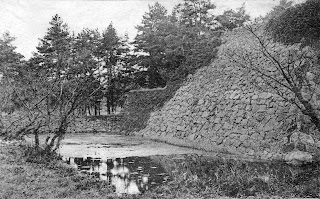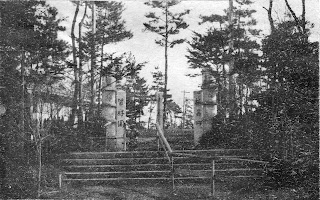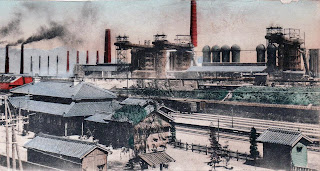Wakamatsu Harbour Panorama
As there is no dining car attached to this train, the Pilgrim, like other wayfarers, least perforce live upon the country through which he passes, so at Saga a bento and a large bottle of milk is purchased at an outlay of 20 sen, from hawkers who cry their wares up and down the platform. The bottle of milk needs no description beyond the statement that its quality left nothing to be desired and, as the bottles are carried in a small tank of hot water, the milk is thus kept warm.
Views of Wakamatsu Harbour
The bento was a two decker arrangement; a handy little box made of pine 1/16 of an inch thick. The lower part was filled with freshly cooked rice, the upper part containing a selection of Japanese food, nicely cooked, neatly arranged and garnished with green stuff and pickles; the whole being completed with a paper serviette, a pair of new hashi (chopsticks) in a sealed envelope which also contained a tooth pick. All for 20 sen and nearly enough for two.
Loading Coal Junks (manpower)
Hemeko-jinsha
For those desiring tea, teapots, part of the double lid of which forms a drinking top are on sale at most of the stations, at a cost of four sen, pot and all included although this latter is invariably left under the seat, to be subsequently collected by the train-boy.
Loading Coal
With regard to the milk bottles, the usual procedure is to pull out the cork and assimilate the contents of the bottle in a series of “swigs” but the Pilgrim, among the articles in his scrip included a drinking cup, a collapsible affair which is apt to play tricks upon the unwary.
The Kokura Station
At the large stations, foreign bento may be obtained. For 30 sen, a dozen delicious ham sandwiches may be purchased, packed tightly in a similar wooden box, with a garnishing of green stuff, serviette and toothpick complete. As the F. B. invariably seems to be ham sandwich, it is apparent that the caterers on the Japanese railway service make no provision for members of the chosen race.
Mokumachi-dori
Thus, however long the journey, no one need starve and if neither of the above mentioned bento (plural uncertain) satisfy the fastidious taste of the alien traveller, then let him travel by express train, to which a dining car is invariably attached and wherein capital four and five course meals are served at a remarkably cheap rate; but by so doing, however, he will miss seeing much that is interesting – incidents of rural life and the habits and idiosyncrasies of the people, - observable during the frequent stoppages at wayside stations.
The Moat - Ogasawara Castle
Travelling by express is also considerably more expensive, particularly if the traveller frequently drops off at some station en route which promises to be interesting, as an “express ticket” has to be purchased for each ‘lap,’ although the traveller may possess a ticket covering the whole journey. Another objection to express trains is the fact that they are invariably uncomfortably crowded.
Ogasawara Castle
Railroad travelling is cheap in Japan and the second class with its comfortably upholstered seats, spacious cars and other conveniences, is good enough for any one - narrikins, shipowners or robber magnates possibly excepted. Narrakin, by the way is a recently coined word and describes the mushroom plutocracy which has sprung up as a result of the war; not necessarily by profiteering, but as a result of looking ahead and being a trifle smarter that one's competitors.
Shiyouzan Kaku
Saga, when visited ten years ago, appeared a sleepy old-world place, with many fine wide streets, temples and public buildings. Seemingly it has changed considerably. Being the seat of the provincial government, Saga cuts a considerable amount of ice. For some occult reason there appears to be a deeply seated feud between the Saga folk and those of Nagasaki - at least, so the writer was informed by a lady resident of the latter place, and one never doubts the ladies.
Kaikosha - The Naval Club
On the occasion referred to, the writer's informant told him that: -
“Wherever a Saga man passes there grass will not grow.”
What the good folk of Saga say of the Nagasaki-ites has yet to be learned, but insofar as Saga and its environs are concerned, the presence or “passing” of its gentlemen appears to exercise no deliterious effect upon the crops, trees, or foliage in general, hence it would seem that there is a mistake somewhere and, like another gentleman who is not so black as he is painted, the Saga man is a much maligned person.
Nakara Kai-Koen
At Tosu, there is another general purchase of bento and tea, and manoeuvres and evolutions with chopsticks follow, one gentleman leaning half out of the window of the moving train, in order to express his opinion of the tea seller, who has landed him with a leaking pot. Later, the Pilgrim views with regret the highly reprehensible practice of throwing superfluous articles out of the window, on to the track.
Yasaka Shrine
Passengers are not wholly to blame in this, as they but follow the lead given by the railway staff. Periodically the train-boy appears with his broom, with which he sweeps the floor of the car, from end to end, finally opening a small, circular trapdoor in the floor, down which he brushes the sweepings, on to the sleepers. The teapots, empty bottles, bento and other articles, too large to go down the trap, are gathered up, the bottles and pots to be subsequently reclaimed, while the rest is flung off the car on the track. The danger of this practice is obvious, as in addition to the possibility of something lodging in an open switch, thus preventing its closing, there is the possibility, not at all an unremote one, of one of the articles disposed of, striking a pedestrian and the impact of an empty bento box carried on by the momentum of a train travelling some X miles an hour, is no laughing matter.
Chiyo-no-matsubara
As in the homeland, here the railway folk appear to have a language of their own, when announcing the name of the stations. Zass. etc. was rendered by a couple of labial explosions and a quack. Beyond its remarkable name, the townlet does not appear to be much of a place - if the inhabitants thereof will pardon this somewhat slighting reference to their home. Its most striking features appear to be its name, together with the fact that it is the station preceding Hakata.
Hakata, which is one of the most important ports in Kyushu, was visited on the return trip and a brief account of same will appear in its proper sequence.
Another matter for surprise, is the behaviour of many people while travelling. Some cases of selfishness are most pronounced, as, for example, when a single passenger with his baggage piled up on the seat beside him, spreads his rug and lies down, thus occupying seating accommodation for about five persons and this, despite, the fact of newcomers entering the car, who stand helplessly, until the train-boy, stirs up the greedy one and provides the newcomer with a seat. Again, the Japanese people although so scrupulously neat and tidy in their own homes, think nothing of piling heavy trunks and baggage upon the velvet upholstered seats, or of strewing the floor with papers, fruit peelings, or ether superfluous litter.
Yedamitsu Steel Works
Soon after leaving Tosu, the train arrives at Zasshoonokuma. The name sounded so Dutch that one involuntarily looked round for the canals with the long, beamy barges and the windmills perched on the dykes. The clattering of sabots was provided by the ditto of geta on the cemented platform, but for the other characteristics one looked in vain.
On the Murasaki-gawa, Kokura
Imari Harbour, Saga
As in the homeland, here the railway folk appear to have a language of their own, when announcing the name of the stations. Zass. etc. was rendered by a couple of labial explosions and a quack. Beyond its remarkable name, the townlet does not appear to be much of a place - if the inhabitants thereof will pardon this somewhat slighting reference to their home. Its most striking features appear to be its name, together with the fact that it is the station preceding Hakata.
Karatsu, Saga
Saga Castle
Hakata, which is one of the most important ports in Kyushu, was visited on the return trip and a brief account of same will appear in its proper sequence.
Nothing interesting developed until the train stopped at a station beyond Hakata the name of which, for reasons which will be obvious, is unknown. The station was having its clean up and paint down and the name board was a blank of new white paint. On another board near by, the artist was painting in an interesting announcement. His work was unfinished and during the brief stoppage, he was at work on what might or might not have been a “ G”. The announcement in its unfinished state was interesting, it being : -
“CHANGE HERE FOR SASAG. . .”
It will always be a matter for regret that the stop was too brief to ascertain beyond all doubt, whether at this little “joint” a supply of the vulgar but succulent sausage is kept on hand for distribution.
Soon after leaving Hakozaki, the train runs along the edge of a beach of clean white sand, from which springs a small pine forest. This is the celebrated Chiyo-no-matsubara and the scenery hereabouts is delightful.
Later on the weather grows distinctly warmer, several windows are opened whereupon a number of flies invade the ear. They are promptly “swatted,” or take their leave again and a general somnolent atmosphere prevails. Eyes close, heads bob, one or two to collide, bringing up their owners wide awake with mutual apologies. A spirit of mischief entering the Pilgrim, he decides to note the effect of a yawn; leads off and then sits by to note the result. The subsequent few minutes again proves the contention that yawning is distinctly infectious, as most of the passengers, who were not already asleep, followed suit in differing keys and periods of duration with an effect that was distinctly comical.
The train is again passing through a coal country and a pall of blank smoke in the distance proclaims the fact that Edamitsu is not far off.
Government Steel Works, Edamitsu
At Edamitsu is situated the Imperial Iron and Steel Works where, from more than thirty gigantic steel smoke stacks, each with its railed gallery near the top, a black cloud of smoke issues, day and night. The works cover an area of nearly 250 acres and were modelled after the Krupp works at Essen. Over 10,000 hands are employed.
This is indeed a black country, as throughout the remaining portion of the way, in place of smiling countryside, there is a succession of factories. Some of the buildings are constructed of fine, white glazed bricks which, despite the smoke and fumes, manage to maintain their colour amid this long succession of cement works, glass, brick, steel and other industrial plants.
At Toba, observing the first of the now familiar notice boards on which the authorities prohibit photographing, aviation, sketching, or otherwise recording the features of the landscape the Pilgrim pats away his note book, as in Japan Regulations are to be rigidly observed and the fool who thinks otherwise as a rule pays dearly for his folly.
Toba Harbour
No exception, however, can be taken to the statement that at 4.55 p. m., punctual to the minute, the train stopped at Moji and gathering up his belongings, the Pilgrim started out in search of an hotel, thus finishing the first ‘lap’ of the pilgrimage.
Saga - "Where Sagaman pass, there will not the grass grow." (Nagasaki proverb)



_edited-2.jpg)


















No comments:
Post a Comment